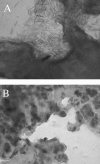Characterization of Stg fimbriae from an avian pathogenic Escherichia coli O78:K80 strain and assessment of their contribution to colonization of the chicken respiratory tract
- PMID: 16952934
- PMCID: PMC1595498
- DOI: 10.1128/JB.00453-06
Characterization of Stg fimbriae from an avian pathogenic Escherichia coli O78:K80 strain and assessment of their contribution to colonization of the chicken respiratory tract
Abstract
In a previous study, ecs-3, a sequence from avian pathogenic Escherichia coli (APEC) O78:K80 strain chi7122, was found to be expressed in vivo in infected chicken tissues. The region encompassing ecs-3 carries a fimbrial gene cluster that is a putative ortholog of the stg fimbrial gene cluster of Salmonella enterica serovar Typhi. This APEC fimbrial gene cluster, which we have termed stg, is a member of a distinct group of related fimbriae that are located in the glmS-pstS intergenic region of certain E. coli and S. enterica strains. Under the control of the pBAD promoter, the production of Stg fimbriae was demonstrated by Western blotting and immunogold electron microscopy with E. coli K-12. Transcriptional fusions suggest that stg expression is influenced by the carbohydrate source and decreased by the addition of iron and that Fur plays a role in the regulation of stg expression. stg sequences were associated with APEC O78 isolates, and stg was phylogenetically distributed among E. coli reference strains and clinical isolates from human urinary tract infections. Stg fimbriae contributed to the adherence of a nonfimbriated E. coli K-12 strain to avian lung sections and human epithelial cells in vitro. Coinfection experiments with APEC strain chi7122 and an isogenic Deltastg mutant demonstrated that compared to the wild-type parent, the Deltastg mutant was less able to colonize air sacs, equally able to colonize lungs, and able to more effectively colonize tracheas of infected chickens. Stg fimbriae, together with other adhesins, may therefore contribute to the colonization of avian respiratory tissues by certain APEC strains.
Figures






Similar articles
-
FNR Regulates the Expression of Important Virulence Factors Contributing to the Pathogenicity of Avian Pathogenic Escherichia coli.Front Cell Infect Microbiol. 2017 Jun 23;7:265. doi: 10.3389/fcimb.2017.00265. eCollection 2017. Front Cell Infect Microbiol. 2017. PMID: 28690981 Free PMC article.
-
Specific roles of the iroBCDEN genes in virulence of an avian pathogenic Escherichia coli O78 strain and in production of salmochelins.Infect Immun. 2008 Aug;76(8):3539-49. doi: 10.1128/IAI.00455-08. Epub 2008 Jun 9. Infect Immun. 2008. PMID: 18541653 Free PMC article.
-
Contribution of the stg fimbrial operon of Salmonella enterica serovar Typhi during interaction with human cells.Infect Immun. 2007 Nov;75(11):5264-71. doi: 10.1128/IAI.00674-07. Epub 2007 Aug 20. Infect Immun. 2007. PMID: 17709421 Free PMC article.
-
Avian pathogenic Escherichia coli (APEC).Vet Res. 1999 Mar-Jun;30(2-3):299-316. Vet Res. 1999. PMID: 10367360 Review.
-
[Avian pathogenic Escherichia coli (APEC)].Berl Munch Tierarztl Wochenschr. 2003 Sep-Oct;116(9-10):381-95. Berl Munch Tierarztl Wochenschr. 2003. PMID: 14526468 Review. German.
Cited by
-
The Diversity of Escherichia coli Pathotypes and Vaccination Strategies against This Versatile Bacterial Pathogen.Microorganisms. 2023 Jan 30;11(2):344. doi: 10.3390/microorganisms11020344. Microorganisms. 2023. PMID: 36838308 Free PMC article. Review.
-
A metabolic operon in extraintestinal pathogenic Escherichia coli promotes fitness under stressful conditions and invasion of eukaryotic cells.J Bacteriol. 2009 Jul;191(13):4427-40. doi: 10.1128/JB.00103-09. Epub 2009 Apr 17. J Bacteriol. 2009. PMID: 19376853 Free PMC article.
-
Functional expression of the entire adhesiome of Salmonella enterica serotype Typhimurium.Sci Rep. 2017 Sep 4;7(1):10326. doi: 10.1038/s41598-017-10598-2. Sci Rep. 2017. PMID: 28871183 Free PMC article.
-
New Insights into the Roles of Long Polar Fimbriae and Stg Fimbriae in Salmonella Interactions with Enterocytes and M Cells.Infect Immun. 2017 Aug 18;85(9):e00172-17. doi: 10.1128/IAI.00172-17. Print 2017 Sep. Infect Immun. 2017. PMID: 28630073 Free PMC article.
-
AatA is a novel autotransporter and virulence factor of avian pathogenic Escherichia coli.Infect Immun. 2010 Mar;78(3):898-906. doi: 10.1128/IAI.00513-09. Epub 2009 Dec 22. Infect Immun. 2010. PMID: 20028805 Free PMC article.
References
-
- Andrews, S. C., A. K. Robinson, and F. Rodriguez-Quinones. 2003. Bacterial iron homeostasis. FEMS Microbiol. Rev. 27:215-237. - PubMed
-
- Arné, P., D. Marc, A. Brée, C. Schouler, and M. Dho-Moulin. 2000. Increased tracheal colonization in chickens without impairing pathogenic properties of avian pathogenic Escherichia coli MT78 with a fimH deletion. Avian Dis. 44:343-355. - PubMed
-
- Babai, R., G. Blum-Oehler, B. E. Stern, J. Hacker, and E. Z. Ron. 1997. Virulence patterns from septicemic Escherichia coli O78 strains. FEMS Microbiol. Lett. 149:99-105. - PubMed
-
- Bahrani-Mougeot, F. K., E. L. Buckles, C. V. Lockatell, J. R. Hebel, D. E. Johnson, C. M. Tang, and M. S. Donnenberg. 2002. Type 1 fimbriae and extracellular polysaccharides are preeminent uropathogenic Escherichia coli virulence determinants in the murine urinary tract. Mol. Microbiol. 45:1079-1093. - PubMed
-
- Bäumler, A. J., A. J. Gilde, R. M. Tsolis, A. W. van der Velden, B. M. Ahmer, and F. Heffron. 1997. Contribution of horizontal gene transfer and deletion events to development of distinctive patterns of fimbrial operons during evolution of Salmonella serotypes. J. Bacteriol. 179:317-322. - PMC - PubMed
Publication types
MeSH terms
Substances
Associated data
- Actions
LinkOut - more resources
Full Text Sources
Other Literature Sources
Medical

